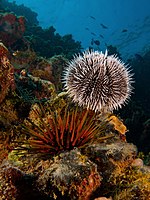
Rapid Photochemical Synthesis of Sea‐Urchin‐Shaped Hierarchical Porous COF‐5 and Its Lithography‐Free Patterned Growth
Sign Up to like & getrecommendations! Published in 2017 at "Advanced Functional Materials"
DOI: 10.1002/adfm.201700925
Abstract: Despite potential advantages of covalent organic frameworks (COFs) in wide area applications, several limitations in conventional solvothermal synthesis, such as long reaction time and high reaction temperature, reduce reaction efficiency and prohibit technical processes for… read more here.
Keywords: cof; urchin shaped; photochemical synthesis; sea urchin ... See more keywords

Single nucleotide editing without DNA cleavage using CRISPR/Cas9‐deaminase in the sea urchin embryo
Sign Up to like & getrecommendations! Published in 2017 at "Developmental Dynamics"
DOI: 10.1002/dvdy.24586
Abstract: Background: A single base pair mutation in the genome can result in many congenital disorders in humans. The recent gene editing approach using CRISPR/Cas9 has rapidly become a powerful tool to replicate or repair such… read more here.
Keywords: crispr cas9; single nucleotide; nucleotide editing; sea urchin ... See more keywords

Distinct regulatory states control the elongation of individual skeletal rods in the sea urchin embryo
Sign Up to like & getrecommendations! Published in 2022 at "Developmental Dynamics"
DOI: 10.1002/dvdy.474
Abstract: Understanding how gene regulatory networks (GRNs) control developmental progression is a key to the mechanistic understanding of morphogenesis. The sea urchin larval skeletogenesis provides an excellent platform to tackle this question. In the early stages… read more here.
Keywords: regulatory states; sea urchin; states control; control ... See more keywords

Effects of ocean climate on spatiotemporal variation in sea urchin settlement and recruitment
Sign Up to like & getrecommendations! Published in 2020 at "Limnology and Oceanography"
DOI: 10.1002/lno.11440
Abstract: Sea urchins are voracious herbivores that influence the ecological structure and function of nearshore ecosystems throughout the world. Like many species that produce planktonic larvae, their recruitment is thought to be particularly sensitive to climatic… read more here.
Keywords: larval settlement; sea; settlement; recruitment ... See more keywords

Enhancement of oil absorption properties of acrylic ester resin hybridized with well‐organized sea urchin‐like MnO2
Sign Up to like & getrecommendations! Published in 2018 at "Polymer Composites"
DOI: 10.1002/pc.24460
Abstract: Acrylic ester resin (AER) is a promising oil-absorbing material for oils and organic solvents absorption because it exhibits high oil retention ability, good swelling properties, and reusability while also being inexpensive, large-scale production, and environmentally… read more here.
Keywords: absorption; like mno2; urchin like; sea urchin ... See more keywords

Anti-inflammatory polyoxygenated furanocembranoids, salmacembranes A–B from the sea urchin Salmacis bicolor attenuate pro-inflammatory cyclooxygenases and lipoxygenase
Sign Up to like & getrecommendations! Published in 2020 at "Medicinal Chemistry Research"
DOI: 10.1007/s00044-020-02620-6
Abstract: Two undescribed polyoxygenated furanocembranoid derivatives, methyl 15-(9-hydroxy-8-methoxy-2,12-dimethyl-15-oxa-bicyclo[10.2.1]pentadeca-2,4,6,11-tetraen-3-yl)propanoate (salmacembrane A) and 1-(16-methyl-2,16-dihydrofuran)-8-methoxy-12-methyl-20-oxabicyclo[10.2.1]pentadeca-2,4,6,11-tetraen-9-ol (salmacembrane B), were isolated from the organic extract of sea urchin Salmacis bicolor (family Temnopleuridae) by extensive chromatographic purification. Their structures were elucidated using… read more here.
Keywords: anti inflammatory; salmacis bicolor; urchin salmacis; inflammatory ... See more keywords

Identification and expression analysis of a TLR11 family gene in the sea urchin Strongylocentrotus intermedius
Sign Up to like & getrecommendations! Published in 2017 at "Immunogenetics"
DOI: 10.1007/s00251-017-1035-1
Abstract: In this study, a homolog of the TLR11 family gene from the sea urchin Strongylocentrotus intermedius (denoted as SiTLR11) was cloned and characterized. The full-length cDNA of SiTLR11 was 2096-bp long, which included 43 bp of… read more here.
Keywords: sitlr11; family gene; tlr11 family; sea urchin ... See more keywords

The role of algal chemical defenses in the feeding preferences of the long-spined sea urchin Diadema antillarum
Sign Up to like & getrecommendations! Published in 2021 at "Aquatic Ecology"
DOI: 10.1007/s10452-021-09873-2
Abstract: The 1983 die-off of the long-spined sea urchin Diadema antillarum was linked to dramatic increases in macroalgal biomass and abundance on Caribbean coral reefs. D. antillarum densities have only recently begun to recover, and on… read more here.
Keywords: spined sea; long spined; feeding preferences; ecology ... See more keywords

Enhanced Hydrogen Evolution over Sea-Urchin-Structure NiCoP Decorated ZnCdS Photocatalyst
Sign Up to like & getrecommendations! Published in 2020 at "Catalysis Letters"
DOI: 10.1007/s10562-020-03202-2
Abstract: Abstract Developing low-cost and high-catalytic photocatalysts is momentous to achieve efficient photocatalytic splitting of water to produce hydrogen. In this study, a 0D–3D structure ZnCdS–NiCoP composite was synthesized by a simple physical mixing method. A… read more here.
Keywords: hydrogen; nicop; sea urchin; urchin structure ... See more keywords

Preparation of flexible bone tissue scaffold utilizing sea urchin test and collagen
Sign Up to like & getrecommendations! Published in 2017 at "Journal of Materials Science: Materials in Medicine"
DOI: 10.1007/s10856-017-5993-5
Abstract: Gonads of sea urchin are consumed in Japan and some countries as food and most parts including its tests are discarded as marine wastes. Therefore, utilization of them as functional materials would reduce the waste… read more here.
Keywords: collagen; bone tissue; sea; sea urchin ... See more keywords

Trace determination of thiram using SERS-active hollow sea-urchin gold nanoparticles
Sign Up to like & getrecommendations! Published in 2017 at "Journal of Nanoparticle Research"
DOI: 10.1007/s11051-017-3839-1
Abstract: AbstractSurface-enhanced Raman scattering (SERS) is greatly structure-dependent on the absorbed nanoparticles. Nanostructures with different novel morphologies show different Raman enhancement factor orders of magnitude. Herein, a unique nanostructure with fruitful SERS-active sites, composed of hollow… read more here.
Keywords: urchin gold; sea urchin; gold nanoparticles; hollow sea ... See more keywords